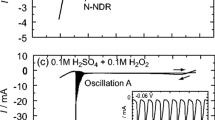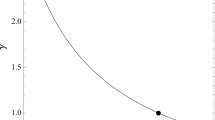Abstract
The anodic dissolution of copper electrode in 1 M trifluoroacetic acid (TFA) was investigated by applying linear sweep and cyclic voltammetry. The current–potential (I–E) polarization curves (voltammograms) were interpreted from the perspective of non-linear dynamics. The obtained results showed that the voltammogram can be divided into three separate regions. As the system was moved away from the thermodynamical equilibrium, the first to appear is the region of stable steady-state (marked as SSS1 region). This region was followed by the region of oscillatory states (the OsS region). The SSS1 → OsS transition is characterized by bifurcation potential, E BIF1 = 0.558 VSCE. The third region, the region of stable steady-state (marked as the SSS2 region) occurs after the OsS → SSS2 transition, and is characterized by the potential bifurcation, E BIF2 = 0.657 VSCE. The cyclic voltammetry measurement has revealed the lack of hysteresis at the SSS1 ↔ OsS transition, and its existence at the OsS ↔ SSS2 transition (the hysteresis width was 34 mV). The results of this study are presented to demonstrate that the voltammograms of the Cu|1 M TFA oscillating electrochemical system can be considered as a bifurcation diagram, experimentally constructed under dynamical conditions.




Similar content being viewed by others
References
Orlik M (2012) Self-organization in electrochemical systems. I: general principles of self-organization. Temporal instabilities, 1st edn. Springer, Berlin
Krischer K, Mazouz N, Grauel P (2001) Fronts, waves, and stationary patterns in electrochemical systems. Angew Chem Int Ed 40:850–869
Krischer K (2002) In: Kolb DM (ed) Advances in electrochemical sciences and engineering, vol 8. Wiley-VCH Verlag GmbH and Co. KGaA, Weinheim
Hudson JL, Tsotsis TT (1994) Electrochemical reaction dynamics: a review. Chem Eng Sci 49:1493–1572
Koper MTM (1998) Non-linear phenomena in electrochemical systems. J Chem Soc Faraday Trans 94:1369–1378
Prigogine I (1984) Order out of chaos: man’s new dialogue with nature, 1st edn. Bantam Books, New York
Prigogine I (2003) Is future given?. World Scientific Publishing C. Pte. Ltd., London
Sazou D, Pagitsas M (1998) Bifurcation to limit cycle oscillations induced by the Ohmic potential drop during the anodic polarisation of iron in 14.8 M H3PO4. J Electroanal Chem 451:77–87
Sazou D, Pagitsas M (2003) Non-linear dynamics of the passivity breakdown of iron in acidic solutions. Chaos Soliton Fract 17:505–522
Barkey D, Chang R, Liu D, Chen J (2014) Observation of a limit cycle in potential oscillations during copper electrodeposition in a leveler/accelerant system. J Electrochem Soc 161:D97–D101
Bard AJ, Faulker LR (1980) Electrochemical methods: fundamentals and application. Wiley, New York
Koper MTM (1992) The theory of electrochemical instabilities. Electrochim Acta 37:1771–1778
Krischer K (2001) Spontaneous formation of spatiotemporal patterns at the electrode|electrolyte interface. J Electroanal Chem 501:1–21
Kiss IZ, Gáspár V, Nyikos L (1998) Stability analysis of the oscillatory electrodissolution of copper with impedance spectroscopy. J Phys Chem A 102:909–914
Nguyen TM, Odermatt J, Grimaudo V, Krämer KW, Fluegel A, Arnold M, Mayer D, Broekmann P (2012) Potential oscillations in galvanostatic Cu electrodeposition: antagonistic and synergetic effect among SPS, chloride, and suppressor additives. J Phys Chem C 116:6913–6924
Yang X, Eckert K, Odenbach KS (2010) Oscillatory Lorentz-force-driven flows during potentiostatic current oscillations in magnetic fields. Electrochem Commun 12:1576–1580
Karantonis A, Karaoulanis D (2011) Conditions of electrochemical resonance under potentiostatic control. Electrochim Acta 56:4119–4125
Potkonjak N, Kolar-Anić Lj, Potkonjak T, Blagojević SN, Anić S (2006) Oscillatory phenomena during anodic copper electrodissolution in trifluoroacetic acid solution. Mater Sci Forum 518:301–306
Karantonis A, Bourbos E, Koutsaftis D (2010) Electrochemical resonance: frequency response analysis of the electrodissolution of copper in trifluoroacetic acid close to dynamic instabilities. Chem Phys Lett 490:69–71
Potkonjak N, Potkonjak T, Blagojević SN, Dudić B, Randjelović DV (2010) Current oscillations during the anodic dissolution of copper in trifluoroacetic acid. Corros Sci 52:1618–1624
Potkonjak N, Nikolić Z, Anić SR, Minić DM (2014) Electrochemical oscillations during copper electrodissolution/passivation in trifluoroacetic acid induced by current interrupt method. Corros Sci 83:355–358
Gorzkowski MT, Wesolowska A, Jurczakowski R, Ślepski P, Darowicki K, Orlik M (2011) Electrochemical oscillations and bistability during anodic dissolution of vanadium electrode in acidic media—Part I. Experiment. J Solid State Electrochem 15:2311–2320
Potkonjak NI (2015) Current electrochemical oscillator: copper–trifluoroacetic acid. PhD Thesis, Faculty of Physical Chemistry, University of Belgrade, Belgrade (in Serbian)
Anić SR, Čupić ŽD (2017) Dynamics and kinetics of complex reaction systems. Contributions of the Professor Emeritus Ljiljana Kolar-Anić. Reac Kinet Mech Cat. https://doi.org/10.1007/s11144-017-1290-z
Sazou D, Pagitsas M (2006) On the onset of current oscillations at the limiting current region emerged during iron electrodissolution in sulfuric acid solutions. Electrochim Acta 51:6281–6296
Sazou D, Diamantopulos A, Pagitsas M (2000) Chemical perturbation of the passive–active transition state of Fe in a sulfuric acid solution by adding halide ions. Current oscillations and stability of the iron oxide film. Electrochim Acta 45:2753–2769
Sazou D (1997) Current oscillations and mass-transport control during electrodissolution of iron in phosphoric acid solutions. Electrochim Acta 42:627–637
Tamamushi R (1966) An “Electrochemical Oscillator”—an electrochemical system which generates undamped electric oscillation. J Electroanal Chem 11:65–68
Strasser P, Eiswirth M, Koper MTM (1999) Mechanistic classification of electrochemical oscillators—an operational experimental strategy. J Electroanal Chem 478:50–66
Koper MTM, Strasser P (1991) Electrochemical oscillators: an experimental study of the indium/thiocyanate oscillator. J Electroanal Chem 303:65–72
Sazou D, Pagitsas M (1993) Current oscillations associated with pitting corrosion processes induced by iodide ions on the partially passive cobalt surface polarized in sulphuric acid solutions. Electrochim Acta 38:835–845
Acknowledgements
This work was supported by the Ministry of Education, Science and Technological Development of Republic of Serbia, throughout Projects No. 172015. Author would also like to express its deepest gratitude to the Professor Dr. Ljiljana Kolar-Anić for her wise guidance throughout wonderful world of the oscillatory phenomena.
Author information
Authors and Affiliations
Corresponding author
Rights and permissions
About this article
Cite this article
Potkonjak, N.I. Consideration about a voltammogram as the bifurcation diagram of oscillating electrochemical systems: a case study of the copper|1 M trifluoroacetic acid oscillator. Reac Kinet Mech Cat 123, 155–163 (2018). https://doi.org/10.1007/s11144-017-1325-5
Received:
Accepted:
Published:
Issue Date:
DOI: https://doi.org/10.1007/s11144-017-1325-5




